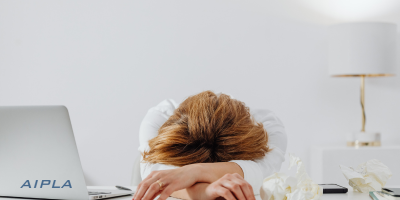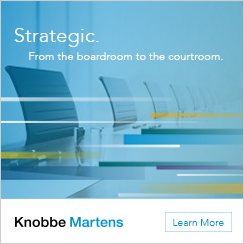Quarterly Journal 47-2
In This Section
The AIPLA Quarterly Journal, a publication of the American Intellectual Property Law Association, is housed at the George Washington University Law School and is edited and managed by an Editorial Board of intellectual property experts and a staff of law students under the direction of the Editor-in-Chief, Professor Joan Schaffner.
The Quarterly Journal is dedicated to presenting materials relating to intellectual property matters and is published four times per year. Editorial Board members (all of whom are lawyers) are selected based upon demonstrated interest and experience, and student staff members are selected from the students of the GWU Law School.
 QJ 47.2 - Social Media Researchers and Terms of Service: Are We Complying With the Law?
QJ 47.2 - Social Media Researchers and Terms of Service: Are We Complying With the Law?
Sara R. Benson
Big data has quickly become a buzz word in large universities. Researchers wish to study the world in which we live, and today they can gather data faster than at any time in the past. Especially data regarding people’s preferences and opinions—as more and more people share information through Twitter, Facebook, YouTube, and the like on a daily basis—can be gathered quickly.
Research using social media provides a wealth of user data for researchers in varying disciplines ranging from law to social science, to computer science and engineering. Thus, the benefits of using social media data are many, including the promise of obtaining up-to-date, relevant, and immediate views about any given topic. The widespread use of social media applications in research, however, does have drawbacks including legal issues surrounding the failure of researchers to comply with terms of service (“ToS”) governing websites and applications containing social media data.
The pilot study resulting in this Article surveyed graduate students and faculty at the University of Illinois about their research practices involving social media ToS. One barrier, which likely led to the small number of researchers willing to voluntarily provide responses to the questions about why they may choose to violate ToS when conducting research, is the fear of criminal liability. That fear has led to a recent lawsuit, discussed below, where social media researchers sued in advance of performing research to determine questions of liability under the Computer Fraud and Abuse Act of 1984 (“CFAA”).
This Article begins by addressing some legal background issues involving the enforceability of ToS attached to websites. Next, it addresses potential causes of action stemming from researchers breaching ToS by website providers. Then it delves into the literature addressing social media and researchers, and finally addresses the terms and findings of the research study engaged in at the University of Illinois, including the methodology, findings, and discussion.
The Article concludes with a recommendation that Congress enact “Aaron’s Law,” which would remove the potential of CFAA criminal liability for researchers engaging in online social media research.
 QJ 47.2 - Cryptokitties, Cryptography, and Copyright
QJ 47.2 - Cryptokitties, Cryptography, and Copyright
Tonya M. Evans
This Article examines the copyright implications of unique, scarce digital creative assets transferred and stored on blockchains, which this Article refers to herein generally as unique crypto assets (UCAs). Specifically, this Article explores the emergence of non-fungible cryptographic tokens (NFTs) created based on the ERC-721 smart contract standard and recorded on the Ethereum public, distributed ledger. This novel standard enables, for the first time, verifiable digital scarcity—an elusive technological characteristic in the world of Web 2.0.
Further, this Article asserts that the ERC-721 token standard empowers UCA holders to maintain control over copyright in their cryptographic creations in gaming, collectibles, and copyright-intensive industries, to name just a few. Those industries are generally controlled by powerful, often siloed, intermediaries that restrict access, regulate transferability, and govern how or whether user-generated digital content may be controlled and exploited by the user.
Presently, for example, if a user crafts a digital sword in the popular video game MineCraft or a creative skin in Fortnite, she cannot transfer that digital good into another platform, at least nto without the platform’s acquiescence based on its contractual terms of use and licensing structure. Of course, the Internet protocol layer—the code itself—does not give a traditional user who generates digital content any automatic or intrinsic right or ability to exploit rights created automatically by authoring creativity fixed in a digital medium.
By contrast, the same sword, if created as an NFT in a decentralized gaming application like Cryptokitties or Decentraland, is the user’s to sell, lend, or use in another virtual world that leverages the ERC-721 (or similar) standard in its application. It is the creator’s public-private asymmetric key pair that secures ownership and control of the token and prevents counterfeiting and piracy. This holds true whether the game ceases operations or the token holder simply chooses to leave that platform altogether. This Article argues that this type of programmable creative self-sovereignty—with the attendant economic benefits that flow from copyright interests—better protects creators than was possible in a pre-blockchain world. ERC-721’s novel coding features provide UCA holders with powerful ownership and control and, for the first time, pure digital scarcity.
 QJ 47.2 - Transatlantic Approaches to Copyright Infringement by Internet Intermediaries
QJ 47.2 - Transatlantic Approaches to Copyright Infringement by Internet Intermediaries
Mary LaFrance
In regulating the internet, both the U.S. and the EU have encountered difficulty in protecting the interests of copyright and neighboring rights owners while still preserving the public interest in free expression and exchanges of information. This conflict is particularly evident in the case of internet intermediaries that host content uploaded by users. While both legal regimes have tried to strike a balance by providing limited safe harbors, content owners complain that the safe harbors are being abused by large-scale hosting sites such as YouTube that generate significant revenue by making copyrighted material available to the public without paying fair compensation to the rightsholders.
Faced with the same problem, these two legal systems appear to be heading in opposite directions. In the U.S., while the case law is not entirely consistent, most courts have interpreted the statutory safe harbors in a manner that strongly favors the intermediaries – in particular, imposing a stringent interpretation of the requisite level of “knowledge” that an intermediary must possess before it faces liability for hosting infringing content. In contrast, the EU is making it significantly more difficult for intermediaries to qualify for the “hosting” exemption from infringement liability. In recent years, the CJEU has narrowed the scope of the exemption by expanding the concept of direct infringement. And in 2019, the EU adopted the controversial “DSM Directive,” under which many hosting sites will be required to take a more active role in monitoring and filtering their user-uploaded content. While it remains to be seen how the CJEU and the individual member states will interpret the Directive, it appears that hosting sites will be subject to significantly different regulatory regimes in the U.S. and the EU. Depending on the stringency of the EU’s filtering obligation, smaller and newer hosting services may find it increasingly difficult to compete with established services such as YouTube.
 QJ 47.2 - The Unfixed Nature of Copyright Fixation: Limited Protection for Environmental Works
QJ 47.2 - The Unfixed Nature of Copyright Fixation: Limited Protection for Environmental Works
Brian Medich
In 2011, the Seventh Circuit refused to extend copyright protection to “Wildflower Works,” an environmental work of art that purposely and artistically incorporated both flowers and permanent materials. In fallaciously deciding that “Wildflower Works” did not deserve the protections allotted pictorial, graphic, and sculptural works, the court held self-sustaining flowers to be unfixed for the purposes of copyright law. Fixation, as defined by the Copyright Act of 1976, requires sufficient permanence or stability and the ability to be perceived, reproduced, or otherwise communicated for a period of more than a transitory duration. This Note proposes that “Wildflower Works” did possess these prerequisites of fixation. First, based on jurisdictional inconsistencies, where differing courts found differing levels of duration acceptable, “Wildflower Works” should be seen as perceivable, reproducible, and otherwise communicable for more than a transitory duration. Second, although the Seventh Circuit would like to interpret fixation as synonymous with permanent, Congress intended an expansive interpretation of the term, and “sufficient permanence” is not eternal permanence.
Further, the Seventh Circuit erred again in analogizing and hypothesizing protection for another work of environmental art, “Puppy,” a 43-foot tall floral sculpture of a dog. In this analogy, the court purported that “Puppy” could be allotted protection based on the inclusion of a metal frame, even though it incorporated impermanent living material. In doing so, the Seventh Circuit failed to provide consistent reasoning for why “Wildflower Works” should not be allotted the same protection, as it too incorporated permanent materials. In 2017, the Supreme Court clarified what can be copyrighted as a pictorial, graphic, or sculptural work and reestablished the test for separability. The Court laid out a two pronged test, stating that “a useful article is eligible for copyright protection if it (1) can be identified separately from, and (2) is capable of existing independently of, the utilitarian aspects of the article.” This Note uses this test to review the protection allotted environmental works, purporting that works of recognized stature, that meet the minimum threshold for creativity, are independently created and authored, and possess sufficient permanence, should be provided copyright protection. As such, “Wildflower Works” should be provided copyright protection, and this Note analogizes to graffiti art and food art to dictate a spectrum of sufficient fixation.
In the end, this Note proposes the “Environmental Works Copyright Protection Act,” as an amendment to the Copyright Act of 1976. This amendment, taking inspiration from amendments that came before it, proposes a new, more limited, contractually based copyright for environmental works. Under this new amendment, this Note argues that environmental works should be protected as pictorial, graphic, and sculptural works of art.
Upcoming Events
-
 AIPLA CLE Webinar: Regulation, Risk & Resilience: The Nexus Between Professional Liability, Duty of Competence & Practitioner Well-Being
AIPLA CLE Webinar: Regulation, Risk & Resilience: The Nexus Between Professional Liability, Duty of Competence & Practitioner Well-Being
February 10, 2026 12:30 PM to 2:00 PM | Eligible for up to 90 Mins CLE
Mental health issues and substance use disorders can affect any practitioner, in any setting, and at any time. Left untreated, they can destroy careers and lives. This program will discuss where the legal profession currently stands in relation to the substantial challenges presented by untreated mental health issues and substance use disorders and examine the nexus between ethical competence under the USPTO Rules of Professional Conduct and practitioner well-being. This program will educate attendees on how to recognize the signs of an impaired attorney, how to approach the colleague and begin a conversation, and discuss the possible disciplinary and professional liability implications of an impaired practitioner’s conduct. In addition, the speakers will present best practices/effective risk management strategies, preventative measures, and proposed policy and well-being initiatives, that practitioners in any practice setting may implement to protect clients, themselves, and other firm members as well as save careers. -
.png?sfvrsn=fb5905da_1) 2026 IP Transactions Bootcamp
2026 IP Transactions Bootcamp
February 12, 2026
This in-person bootcamp is designed to provide practical insights and strategies for professionals working in intellectual property transactions. The day features a comprehensive agenda including: Panels and CLE Sessions: Learn about Working with Tech Transfer Offices, Strategies for successful collaborations between nonprofits and industry, and Protecting and monetizing an AI asset. Drafting and Negotiating Tips: Get practical advice on drafting and negotiating strategic collaboration and license agreements. Hands-on Workshop: Participate in a Mock licensing negotiation to put your skills to the test. Networking: Conclude the day with a dedicated Networking reception. -
.png?sfvrsn=48c235e_1) 2026 Patent Prosecution Bootcamp - Arlington, VA
2026 Patent Prosecution Bootcamp - Arlington, VA
March 4 to 6, 2026 | Up to 1235 minutes, including 60 Ethics minutes
The 2026 Patent Prosecution Bootcamp is a comprehensive, CLE-accredited seminar that includes instructional lecture-style sessions with practical tips on U.S. and international patent preparation and prosecution, as well as hands-on interactive workshops that will walk you through drafting claims and responding to office actions. -
2025 Women in IP Global Networking Event
April 16, 2026
-
2026 Spring Meeting - San Francisco, CA
May 13 to 15, 2026
We’re excited to welcome you to the 2026 AIPLA Spring Meeting, where innovation, technology, and intellectual property come together to shape the future. San Francisco is ready for your ideas, energy, and passion for IP!

